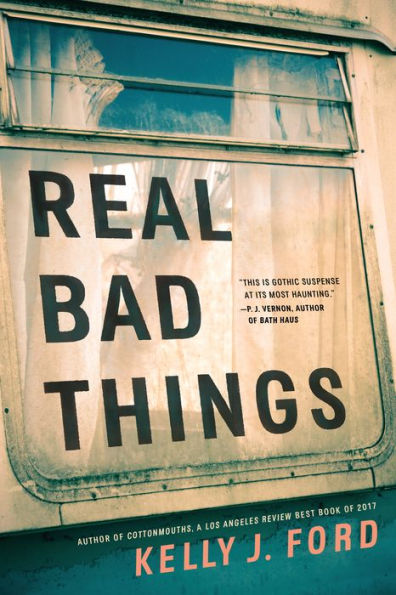A Review of Kelly J. Ford’s Real Bad Things
By Wiley Reiver
As I made my way through Kelly J. Ford’s stellar second novel, I kept thinking of how much Flannery O’Connor would have enjoyed and appreciated this story. Now, stay with me here. I’m entirely confident that as an artist with a cogent, comprehensive theory of how fiction (worth the name) is constructed, she’d admire and affirm Ford’s superbly honed skills.[1] Those skills yield here a compelling and aesthetically sophisticated exploration of memory and trauma, of the violences we can inflict on ourselves and one another in the often noose-like strictures of family or friendship, and the loyalties and desires that somehow, sometimes, perdure. (Which also makes Real Bad Things one more counterexample to the supposedly uncrossable differences between genre and literary fiction.)
In a moment I’ll detail how Ford so adeptly achieves the essential aims of fiction as delineated by O’Connor. But I’ll first summarize the story and main characters. Jane Mooney is the forty-something androgynously queer daughter of Diane and an unknown, likely Asian-American man. Twenty years ago she escaped Maud’s Bottom, a down and out Arkansas locale, crouched on flooding bottom lands beneath Maud Proper, where the haves enjoy lives Jane could only dream about when growing up. She left after she confessed to the intentional homicide of Warren Ingram, a mean alcoholic and one of the parade of horribles that constitute Diane’s relationships. Despite her declaration, she was released by the police for lack of corroborating evidence. (As a former law professor and public defender, I’ll confess to thinking this is a bit of a narrative stumble. But you’re going to get that in many novels of the complexity we’re dealing with here.) Moreover, Jane did her best to protect her younger brother Jason while they grew up, but they’ve grown estranged in the years since she fled.
There’s also Georgia Lee, whose life was deeply entwined with Jane’s before Warren’s death. Now she’s an unhappily married parent; her spouse and teenage sons are “[t]hree mouths morphing into one giant want she didn’t have the energy or inclination to fill anymore.” Her pharmacy job is a dead-end, and her cretinous boss is likely going to unseat her from the city council position she’s been in for years. Little surprise, therefore, that she eats and drinks to escape. Though there were tensions between Georgia Lee and her, Annie Pham was also important to Jane when they were growing up. She’s another person Jane lost touch with, just as she’s one more person not entirely overjoyed to see Jane return to Maud Bottom in the wake of Warren’s bones being found in the river, ostensibly to accept whatever punishment the state might now intend to impose. What’s mystifying, and what imbues this story with rocketing propulsion, is Jane’s strange willingness to meet the criminal justice system more than halfway.
Clearly, we have on our hands a helluva enticing story. What makes Real Bad Things a helluva novel is the skill with which Ford builds the world in which these complex, human, all-too-human characters exist. Turning now to O’Connor’s theory of fiction, presented in her essay “The Nature and Aim of Fiction,” I’ll try to show the most important ways Ford does this.[2]
The first is the wealth of sensory detail Ford works into the narrative. O’Connor’s explanation for why this is a sine qua non of successful fiction deserves to be quoted at length:
We will be concerned in this with the reader in his fundamental sense, because the nature of fiction is in large measure determined by the nature of our perceptive apparatus. The beginning of human knowledge is through the senses, and the fiction writer begins where human perception begins. He appeals through the senses, and you cannot appeal to the senses with abstractions.
Ford helps create Gardner’s vivid and continuous dream to a great extent because of how she uses such concrete sensory details. Diane’s abortive commitment to physical health long ago is depicted by the “set of faded purple dumbbells” Jane finds among the other junk filling what used to be her bedroom. A character’s fight against aging is shown in the “day-old foundation collected in the lines of her face.” A retail worker’s smile is described as “quick . . . exhausted and bracing.” The impact of the neglect and trauma of Jane’s and Jason’s childhoods is revealed in how Jason colors when a little boy: “his little digits clutching the crayon in his fist, not looking up from the storm of dark colors he’d circled over and over on the page. Little bits of paper torn off from the violent swirls.” A porch-bound old woman in Maud Bottom fans herself with a Frisbee. The adult version of Jason dresses as if to shield himself with protective carapace: “he wore an ironed black button-down, mirrored sunglasses, and waxed black jeans.” The poverty and squalor of a childhood home is represented by the splatter of vegetable oil on the wall behind the stove and the “oddly sweet scent of roach spray” Jane couldn’t forget. Such details pepper virtually every page. This novel is utterly convincing and compelling because of them.
Further, for O’Connor, the gradual accumulation of sensory details yields the multi-layered quality of good fiction. We’re talking, to be more specific, about the presence of symbols. The best kind rise organically from a skillful appeal to senses, and here again Ford displays her skills. I envy the reader who still has yet to discover the meaning and emotional resonance Ford creates with physical objects like pizza crusts, drooping eyelids, or the picture that didn’t appear in a high school yearbook as they rise through her storytelling to the level of vital symbols. Then there’s what’s represented in a nauseating moment of a man forcing a teen girl’s mouth open to spit repeatedly into it. And I don’t think I’m giving away too much by asserting that the recovered bones of Warren represent so much about each of the central characters’ choices and lives.
So that’s my prima facie case for why O’Connor would consider this a very good work of fiction and why I do as well. But there are still other reasons why Real Bad Things works so well. I’ll highlight briefly three. First, Ford very skillfully reveals the circumstances that led to Warren’s murder. We know from the beginning that there’s something deeply wrong with Jane’s assertion that she’s solely responsible for the killing, but Ford ratchets up our desire to know just what actually happened to this beer-sweaty bastard, and why, through a series of fragmented admissions or aversions from multiple characters. She keeps a complete answer to what really happened tantalizingly out of reach over dozens and dozens of pages without ever torquing the plot or characterization to achieve her effects. The culminating result is one of the most elegantly developed reversals I’ve come across in contemporary crime fiction.
In addition, there’s the story’s sometimes acidic, sometimes surreal, always distinctive dark Southern humor. Jane is nicknamed “Lezzie Borden,” and if you don’t find that, if not only funny, also funny, well, all right I guess. Also, Ford’s description of a barfly fumbling her hand in a jar of pickled eggs has the tone and details of a species of Southern humor, particularly given the shanking she further accomplishes of Northerners who stereotype and romanticize the rural South.
Finally, Real Bad Things is signal contribution to the still-very-needed expansion of the crime genre. I can do no better than to let the author make the case herself. In a recent interview, Ford rightly stated that she “refuse[s] to let someone’s entitlement to a genre stop me from writing about crime from a queer, female perspective. If anything, it fuels my fire and that of other marginalized authors. . . . [W]e’re changing the genre for good.” In at least, I only add, two senses of “good.”
I’ll conclude by returning to O’Connor’s essay on fiction writing once more. She declares that “there’s a certain grain of stupidity that the writer of fiction can hardly do without, and this is the quality of having to stare, of not getting the point at once.” If that’s true, then Ford is a stupendously stupid writer. You don’t get the quality of this novel without a lot of looking, at the world around oneself as well as within oneself. (It’s a fair inference that there are substantial biographical influences in the book.) And for good fiction to result, such looking continues until the author can offer honesty, compassion, wisdom, and bracing insight into our lovely, damnable condition.
Which is why we must hope Ford never smartens up.
[1] And I’ll just note in passing that, while in other, quite different contexts O’Connor might raise objections to the same-sex relationship in the novel, when taking Real Bad Things as a work of art simpliciter, that element wouldn’t affect her assessment as a clear instance of successfully wrought fiction. Cf., for example, O’Connor’s literary friendship with John Hawkes and her appreciation of his decidedly non-Catholic novels in The Habit of Being.
[2]I exaggerate, but I don’t exaggerate much, when I say that “On the Nature and Aim of Fiction,” as a primer for literary craft, is all you need to understand what’s demanded of fiction writers and why good writing is so damn hard (and thus rare).


Wiley Reiver
Wiley Reiver is from the South Carolina Lowcountry but currently lives in Vermont’s Northeast Kingdom. He works in university administration. He’s also been a picture framer, college English teacher, ESL instructor in Iraq, racetrack bathroom cleaner, and very bad maker of donuts. He holds an MFA from the University of Southern Maine. His fiction and nonfiction work has appeared under other names in the New York Times, Fried Chicken and Coffee, the Civil War Monitor, and The Dead Mule School of Southern Literature. He’s at work on a New Orleans crime novel. Twitter: @SFWriter3.
